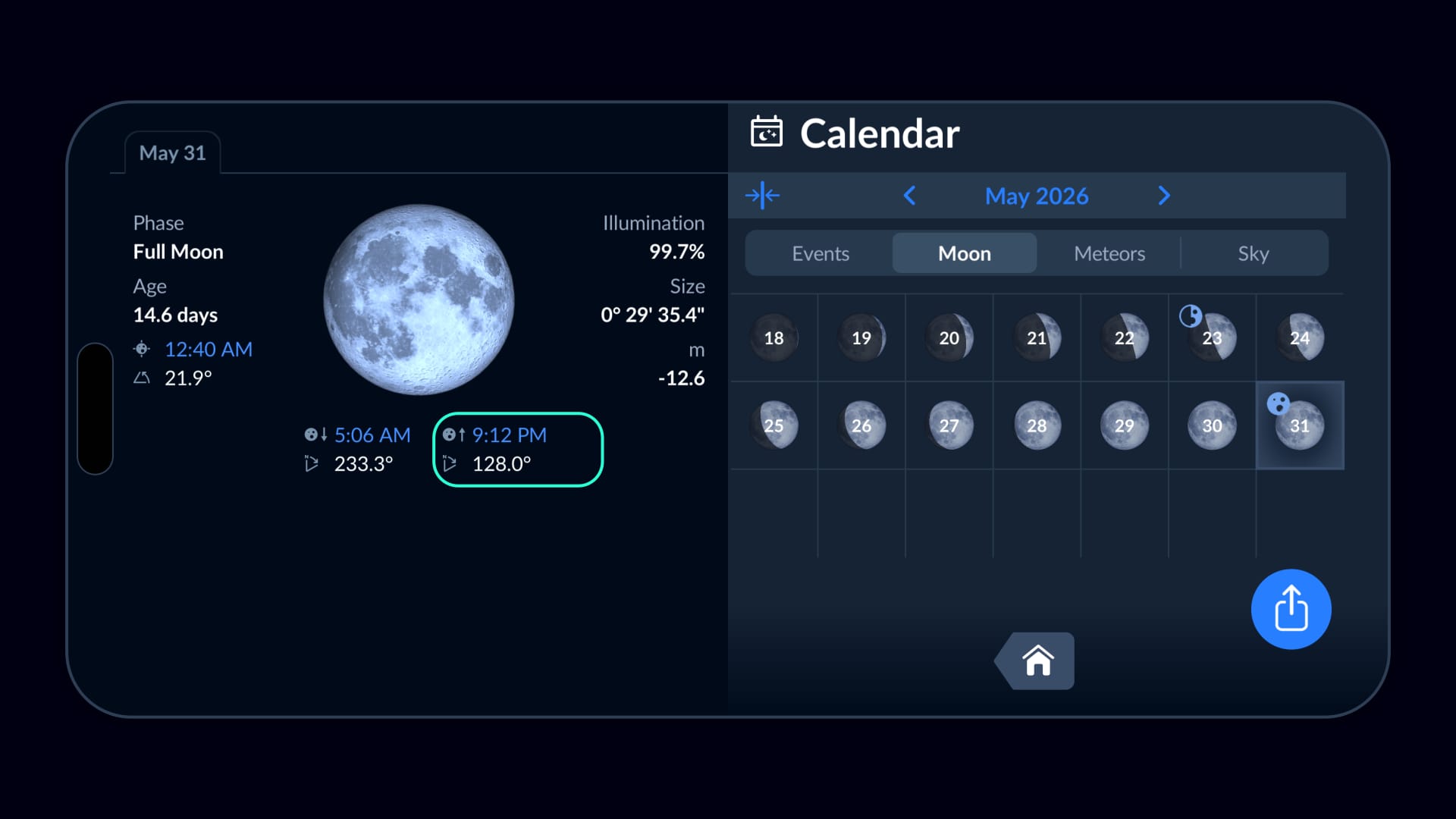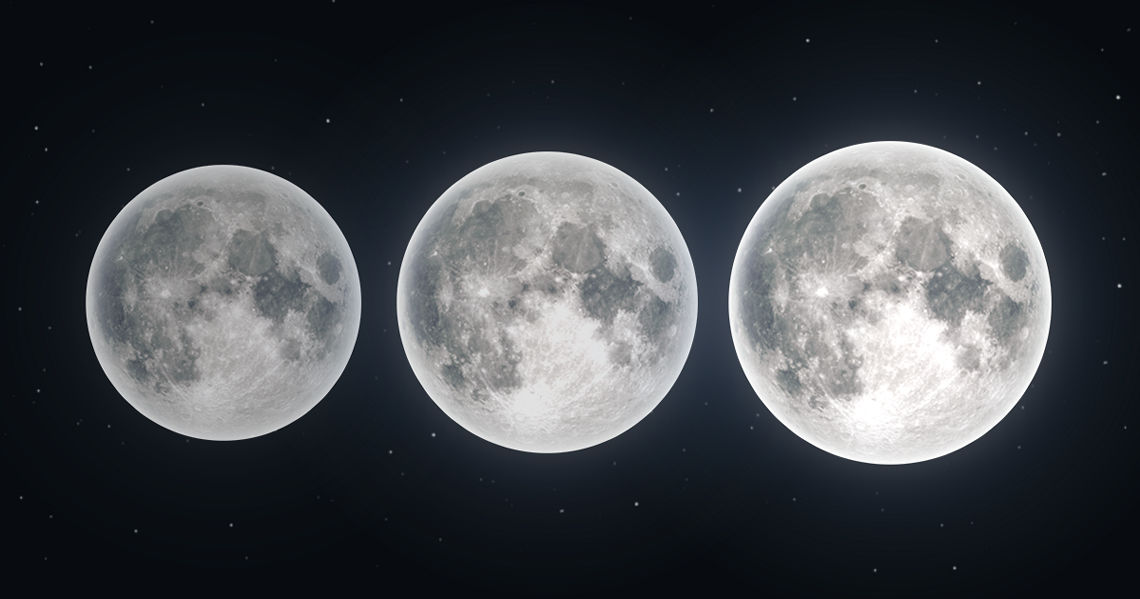Meet the Second Full Moon in May: The Blue Moon of 2026
May gets two Full Moons! The second one, called the Blue Moon, arrives on May 31, 2026. This one also occurs near the Moon’s farthest point from Earth (apogee) for 2026, so it’s the year’s smallest Micromoon. In this guide, we’ll break down the science, traditions, and share simple photo tips for this Blue Micromoon. Open the free Sky Tonight app to get your precise moonrise time and track the Moon in real time.
Contents
- Full Moon on May 31, 2026: Quick Facts
- Lunar Calendar for May 2026
- What Zodiac Sign Is the May Blue Moon in?
- May Blue Moon Meaning
- May Micromoon Meaning
- How to See and Photograph the Blue Moon in May 2026?
- May Blue Moon 2026: F. A. Q.
- May Blue Micromoon 2026: Conclusion
Full Moon on May 31, 2026: Quick Facts
- Date/time (exact moment): May 31, 2026, 08:45 GMT
- Common names: Calendrical (monthly) Blue Moon, Micromoon
- Constellation: Scorpius
- Visibility: To the naked eye, appears fully illuminated from May 30 to June 1; check local moonrise times
Lunar Calendar for May 2026
When Is the Full Moon in May 2026?
In May 2026, there are two Full Moons: the first is on May 1 at 17:23 GMT, and the second is on May 31 at 08:45 GMT.
May Moon Phases 2026
- Full Moon (Flower Moon): May 1, 17:23 GMT
- Last Quarter: May 9, 21:11 GMT
- New Moon: May 16, 20:01 GMT
- First Quarter: May 23, 11:11 GMT
- Full Moon (Blue Moon): May 31, 08:45 GMT
Which Full Moon in May Is the Blue Moon?
The Blue Moon is the second Full Moon of May, which occurs on May 31. This is a monthly Blue Moon – so named because it is the second Full Moon within a single calendar month. If you’d like to learn more about the first Full Moon of May, see our guide on the May 1 Full Moon.
What Time Will the Full Blue Moon Rise?
The time of moonrise depends on your location. Some places far west of UTC will see their Full Moon rise on May 30, while most cities in the Americas, Europe, Africa, Asia, and Australia will see it rise on May 31. Expect the Moon to rise around the time of local sunset.
Below are local moonrise dates and times for several major cities:
- Honolulu, Hawaii: 19:03 HST on May 30;
- Sydney: 16:26 AEST on May 31;
- São Paulo: 17:32 BRT on May 31;
- Singapore: 19:06 SGT on May 31;
- Mexico City: 19:48 CST on May 31;
- Los Angeles: 20:50 PDT on May 31;
- New York City: 21:11 EDT on May 31;
- Chicago: 21:13 CDT on May 31;
- London: 22:04 GMT on May 31;
You can check the exact moonrise time for your date and location with the free Sky Tonight app – use it as your pocket Moon calendar!

What Zodiac Sign Is the May Blue Moon in?
Astronomically, the May 31 Blue Moon will be located on the border between the constellations Scorpius and Ophiuchus. In astrology, though, it’s said to be in the sign of Sagittarius. So who’s right? In our article, we explain why zodiac signs no longer match the real constellations. And the best proof of the Moon’s true position is simple: go outside and find it in the sky above you!
Blue Moon Meets Antares on May 31
On the Full Moon night, the Moon will pass near Antares (α Scorpii) – the bright, orange-red heart of Scorpius. This striking pairing will be easily visible to the naked eye, with Antares shining at a magnitude of 1 beside the glowing disk of the Blue Moon.
In some southern regions, the event will be even more impressive: the Moon will briefly cover Antares, creating a lunar occultation. This event will be visible from parts of Antarctica, Argentina, Chile, Bolivia, and nearby areas.
Fun fact: the name Antares comes from ancient Greek and means “rival of Mars” (anti-Ares) – early skywatchers often confused its deep reddish color with that of the Red Planet. Read our dedicated article to learn more about Antares.

May Blue Moon Meaning
Why Is the Full Moon on May 31 Called a Blue Moon?
The Full Moon on May 31, 2026, is called a calendrical Blue Moon because it's the second Full Moon in the same calendar month (the first one taking place on May 1). The exact origin of the name is unclear, but some trace it back over 400 years to a time when “Blue Moon” referred to something so unlikely that it was thought to never happen, which is where the English expression “once in a blue moon” originates.
Blue Moons are also unusual among traditional Full Moon names, most of which are tied to seasonal features, like the Flower Moon, Cold Moon, or Harvest Moon.
Will the Moon Actually Look Blue?
The Blue Moon doesn’t actually turn blue. Its familiar yellow-white color remains the same unless unusual atmospheric conditions – such as volcanic dust or wildfire smoke – scatter light in a way that tints the Moon. That color shift is rare and unrelated to the Blue Moon name.
Curious what colors the Moon really can appear in our sky, and why? Take our Moon Colors Quiz to explore the science behind them in a fun way!

What Does a Calendrical Blue Moon Mean?
A calendrical (or monthly) Blue Moon simply means the Blue Moon is defined by the calendar, not by the seasons: it’s the second Full Moon within one month. This is possible because the lunar cycle lasts 29.5 days, which is slightly shorter than most months. So if a Full Moon occurs at the very beginning of a month, there’s enough time for another one to appear near the end of the same month.
Apart from calendrical, there are also seasonal Blue Moons. We break down the science and myths behind Blue Moons in more detail in our dedicated article – check it out to learn what Blue Moons really are.
May Micromoon Meaning
What Does a Micromoon Mean?
A Micromoon is a Full or New Moon that occurs near apogee – the point where the Moon is farthest from Earth in its orbit. Because it’s a bit farther away than usual, the Moon’s disk looks slightly smaller and dimmer. The opposite (and more famous) event, called a Supermoon, happens when a Full or New Moon occurs near perigee, the Moon's closest point to Earth, making our natural satellite appear larger and brighter.
Prefer a visual explanation? Check out our infographic on Supermoons and Micromoons and find out when the next Supermoon will occur!

Will the May Full Moon Look Small?
The May 31 Blue Moon will be the smallest Full Moon of the year, appearing about 5.5% smaller and 10.5% dimmer than an average Full Moon. In practice, this change is quite subtle, so most observers won’t notice anything unusual just by looking. The best way to see the size difference is to photograph this Full Moon and compare it with pictures of other Full Moons taken using the same camera settings – the smaller disk will stand out in a side-by-side comparison.
How to See and Photograph the Blue Moon in May 2026?
The Moon reaches its exact full phase on May 31 at 08:45 GMT, but to the naked eye it will look full from May 30 to June 1. For the most impressive view, watch it at moonrise or moonset, when it glows with a warm golden tint and sits low over the landscape.
The Full Moon rises around local sunset in the east and sets around local sunrise in the west. To get precise moonrise and moonset times for your location, open Sky Tonight, go to the Calendar, select the Moon tab, and choose May 31, 2026.
Viewing & photo tips:
- By eye / with binoculars:
The Full Moon is easy to spot without equipment, and it’s even too bright to observe with a telescope. With binoculars, you can zoom in and see the dark lunar maria in more detail.
- With a smartphone:
Tap to focus on the Moon, then lower the exposure so the Moon doesn't look blown out. Turn on a 2–3-second timer and shoot a short burst of photos – later, pick the sharpest one.
- Camera – close-up of the Moon:
Switch to manual focus and set it to infinity for sharper, more defined lunar edges. As a starting point, try ISO 200–400, a shutter speed of 1/250–1/500 s, and an aperture of f/5.6–f/8. Then adjust to bring out sharp crater details.
- Camera – Moon with landscape:
Shoot around golden hour or blue hour near moonrise. Use bracketed exposures, then combine them in HDR to balance the bright Moon and the darker foreground.
Micromoon composition tip: To make the small-looking Moon appear larger relative to the foreground, step back and use a longer focal length (around 200–400 mm or more) to compress the perspective and emphasize the Moon in your frame.
May Blue Moon 2026: F. A. Q.
When is the next Full Moon in 2026?
After the two May Full Moons (on May 1 and May 31), the next Full Moon will occur on June 29 – this one is known as the Strawberry Moon. You can learn more about the June Full Moon in our dedicated article.
Will there be a Blue Moon in 2026?
Yes, there will be a Blue Moon in 2026. It occurs on May 31 and is classified as a monthly (calendrical) Blue Moon because it’s the second Full Moon in the month of May.
When is the next Blue Moon?
After the monthly Blue Moon on May 31, 2026, the next one will be a seasonal Blue Moon on May 20, 2027. The following monthly Blue Moon will then occur on December 31, 2028.

Is there a Blue New Moon?
“Blue Moon” is traditionally defined only for Full Moons. However, a similar situation with New Moons, when there are two New Moons in one month or an extra New Moon in a season, is possible. This type of event is usually referred to as a Black Moon, not a “Blue New Moon.” You can learn more about Black Moons and find out when the next one occurs in our dedicated article.
May Blue Micromoon 2026: Conclusion
In May 2026, we get two Full Moons: the first on May 1 and the second on May 31. That second one is the monthly Blue Moon. It also occurs near the Moon’s year’s farthest point from Earth, making it the smallest Micromoon of the year. But that doesn’t make it any less impressive! The May Blue Micromoon is still a beautiful sight to observe, especially with the bright red star Antares shining nearby in Scorpius.
Check the moonrise time for your location in the free Sky Tonight app, head outside, and enjoy the unique view of the May Blue Micromoon!
